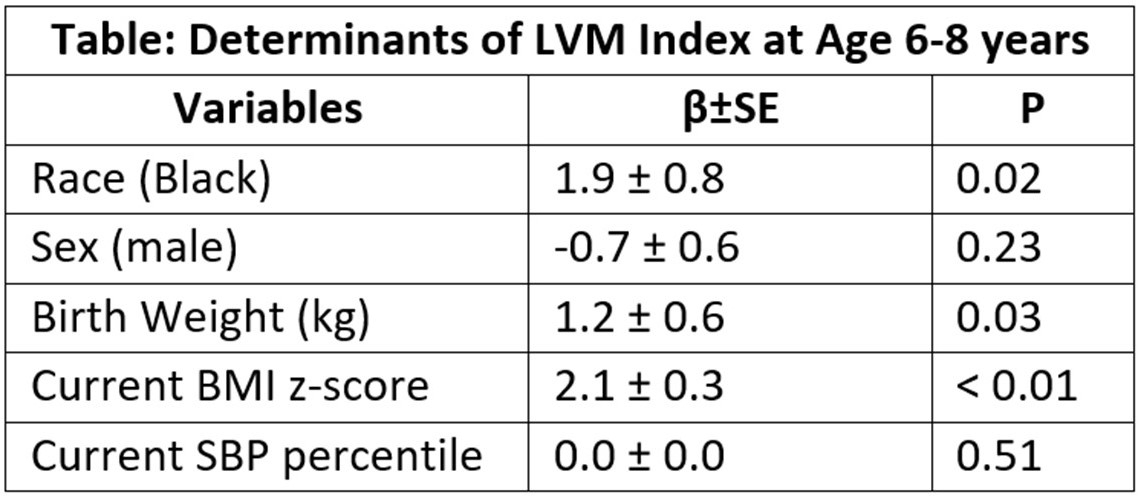Final ID: Su2004
Birthweight is Associated with Left Ventricular Mass Index in Childhood
Abstract Body (Do not enter title and authors here): Introduction/Background: Increased left ventricular mass (LVM) is a risk factor for adult CV disease and is associated with cardiac development in utero. Associations of birthweight with LVM have been demonstrated in young children and adolescence, however, the association between birth weight and LVM in mid-childhood is not well described.
Research Questions/Hypothesis: Utilizing an existing longitudinal data set of healthy children, we aimed to determine the association of birthweight to increased LVM at 6-8 years of age.
Methods/Approach: A longitudinal cohort of 372 term-born children was enrolled at age 3 and followed until age 6-8 years. Anthropometrics, echocardiography, and maternal recall of birth weight were collected. LVM from echocardiography was indexed to height 2.7. Multiple linear regression analysis was performed to assess the association of birthweight with LVM index at 6-8 years of age, adjusting for race, sex, body mass index (BMI) z-score, and systolic blood pressure (SBP) percentile collected at the time of echocardiography.
Results: 303 children were included in the analysis (21.5% Black and 88.5% White, mean age 7.4 ± 0.3 years at the time of echocardiography, mean birthweight 3.4 ± 0.6 kg, mean SBP percentile 42.7 ± 21.6 percentile). Greater birthweight significantly contributed to greater LVM index (1.2 ± 0.6, p = 0.03), along with Black race (1.9 ± 0.8, p = 0.02) and greater current BMI z-score (2.1 ± 0.3, p < 0.01). Sex and SBP percentile were included in the model but were not significantly related to LVM index (p = 0.23 and 0.51 respectively) in this analysis.
Conclusions: Greater birthweight is significantly associated with greater left ventricular mass in childhood, independent of BMI z-score at the time of echocardiography. This suggests a critical period in fetal cardiac development that affects cardiac structure in mid-childhood.
Research Questions/Hypothesis: Utilizing an existing longitudinal data set of healthy children, we aimed to determine the association of birthweight to increased LVM at 6-8 years of age.
Methods/Approach: A longitudinal cohort of 372 term-born children was enrolled at age 3 and followed until age 6-8 years. Anthropometrics, echocardiography, and maternal recall of birth weight were collected. LVM from echocardiography was indexed to height 2.7. Multiple linear regression analysis was performed to assess the association of birthweight with LVM index at 6-8 years of age, adjusting for race, sex, body mass index (BMI) z-score, and systolic blood pressure (SBP) percentile collected at the time of echocardiography.
Results: 303 children were included in the analysis (21.5% Black and 88.5% White, mean age 7.4 ± 0.3 years at the time of echocardiography, mean birthweight 3.4 ± 0.6 kg, mean SBP percentile 42.7 ± 21.6 percentile). Greater birthweight significantly contributed to greater LVM index (1.2 ± 0.6, p = 0.03), along with Black race (1.9 ± 0.8, p = 0.02) and greater current BMI z-score (2.1 ± 0.3, p < 0.01). Sex and SBP percentile were included in the model but were not significantly related to LVM index (p = 0.23 and 0.51 respectively) in this analysis.
Conclusions: Greater birthweight is significantly associated with greater left ventricular mass in childhood, independent of BMI z-score at the time of echocardiography. This suggests a critical period in fetal cardiac development that affects cardiac structure in mid-childhood.
More abstracts on this topic:
A Focus for Improvement - Factors for Lab Adherence in a Pediatric Preventive Cardiology Program
Holsinger Hunter, Porterfield Ronna, Taylor Makenna, Dresbach Bethany, Seipel Brittany, Igwe Chukwuemeka, Alvarado Chance, Tran Andrew
Advanced maternal age and association with major adverse cardiovascular events from NHANES from 1999 to 2018Mehta Adhya, Honigberg Michael, Kennedy Jamie, Spitz Jared, Sharma Garima, Agboola Olayinka, Satti Danish Iltaf, Harrington Colleen, Scott Nandita, Sarma Amy, Saad Antonio, Sullivan Scott, Epps Kelly

